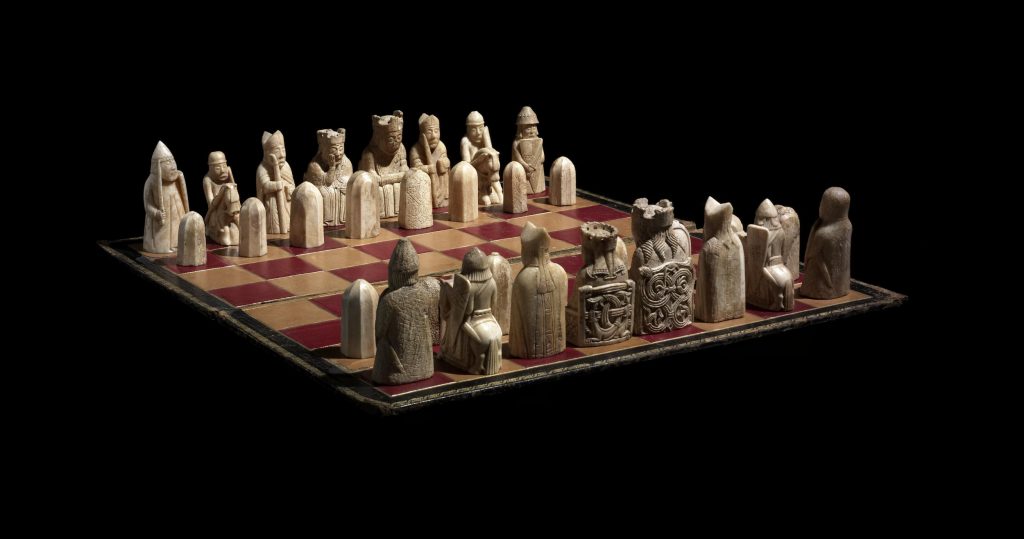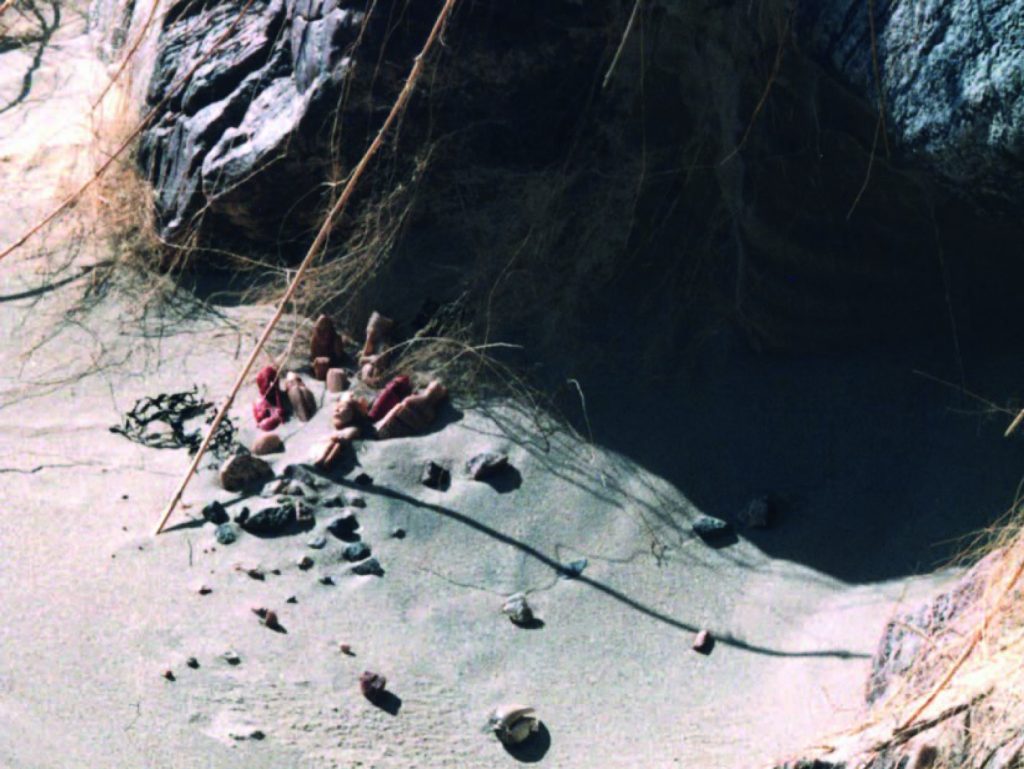Lewis Chessmen/ Fir Thàileisg Leòdhais
The Lewis Chessmen were found in 1831 on Uig Bay, Ardroil.
There are few stories associated with the finding of the chess pieces in the early months of 1831 in the sand dunes above the shores of Uig Bay. One is that Malcolm Macleod, Calum nan Sprot, of Penny Donald found them. Perhaps an unusually high tide had exposed the pieces, and Calum nan Sprot came upon then by chance. But the actual circumstances of the discovery do not seem to have been recorded.
The twelfth century Lewis Chess Pieces have been described as ‘the outstanding ancient chessmen of the world.’ They form that largest and finest group of early European chess pieces to have survived.
Ninety-three objects are known today in museum collections; seventy-eight chess pieces, forteen gaming pieces and one belt buckle. The chess pieces appear to make up the remains of at least four original sets.
Chaidh fir tàileisg Leòdhais a lorg ann an 1831 air Bàgh Ùig, Eadar Dhà Fhadhail.
Chan eil mòran seanchais air mar a chaidh na fir-tàileisg an lorg as t-earrach 1831 sna bacan gainmhich os cionn tràigh Camas Ùige. ’S e aon dhiubh, gun do lorg Calum MacLeòid, Calum nan Sprot, à Peighinn Dhòmhnaill iad. Is dòcha gun tug làn neo-àbhaisteach àrd na mìrean am follais agus gun do thachair Calum nan Sprot orra. Co-dhiù, tha e glè choltach nach deach iomradh air dè dìreach a thachair a chlàradh.
Canaidh cuid mu na fir-tàileisg, a lorgadh ann an Leòdhas san dara linn deug, gur iad ‘prìomh fhìr-tàileisg àrsaidh an t-saoghail’. ’S iad an cruinneachadh as motha agus as grinne a th’ ann de mhìrean tàileisg tràth-Eòrpach.
Tha 93 mìr ann an cruinneachaidhean Mhuseuman an-diugh; 78 mìr tàileisg, 14 fear-dàmais agus aon bhucall criosa. A rèir coltais, tha na tha air fhàgail de, co-dhiù, ceithir seataichean ann.

What are they made from?
All the pieces found in Uig Bay had been carved from walrus tusk. Norse sagas and poems tell of expeditions to the northern seas beyond the arctic circle, to capture the animals. Walrus ivory was much used by Scandinavian and other European sculptures for prestigious objets, which were extensively traded.
Cò dheth a tha iad air an dèanamh?
Bha a h-uile pìos a chaidh a lorg ann an Camas Ùige air a shnaigheadh à sgor-fhiaclan uàlrais. Tha sàgathan agus bàrdachd nan Lochlannach ag innse mu thurais-cuain tuath air Cearcall an Artaig airson na beathaichean seo a ghlacadh. Bha mòran ìbhri uàlrais air a cleachdadh aig snaigheadairean Lochlannach agus Eòrpach airson pìosan clìùiteach a shnaigheadh, agus bha fèill mhòr orra.

The Lewis Chessmen set
You can see the full chess collection via The British Museum website where they are currently
being exhibited and at the National Museum of Scotland.
See more of the lewis chessmen in our gallery
Series: The Lewis Chessmen © The Trustees of the British Museum
See more of the collection over at the other museums
From the style of carving and dress, the pieces have been dated to the mid to late twelfth century and are certainly Norse in origin.
They may have been produced by one or several workshops in Trondheim, Norway, where a similar piece was unearthed. Norse occupation of the Western Isles lasted for nearly five centuries and the chessmen may have been hidden towards the end of our Viking period.
Lewis was part of the Norse Kingdom at the time that the pieces were made and would have had an important place in politics of the western seaboard.
Nothing about the circumstances of their discovery can help us to date them. Very few of the similar chess pieces in collections in London, Norway and Ireland have been found in dated context.
Bha Leòdhas mar phàirt den rìoghachd Lochlannach aig an àm a shnaigheadh na fir-tàileisg agus bhiodh àite cudromach aice ann am poilitigs an taoibh shiair.
Chan eil fiosrachadh sam bith co-cheangailte
ri mar a lorgadh iad gar cuideachadh le deit a chur orra. Is e glè bheag de mhìrean tàilesig coltach riutha ann an cruinneachaidhean a Lunnainn, Nirribhidh, agus Èirinn air an urrainn aois a chur.


However, the carved details on the thrones, the clothing, hairstyles, arms and armour all have parallels in 12th century art, architecture and archaeological objects.
A dh’aindeoin sin, tha am mion-shnaigheadh air na rìgh-chathraichean, an t-aodach, am falt, agus an t-armachd, uile glè choltach ri ealain, ailtireachd agus arc-eòlas na 12mh linn.
We can only guess why the chess pieces were found buried in the sand dunes above Uig Bay.
The seaways of Western Scotland must have been busy with merchant ships plying their way between and beyond France, Spain, Ireland, Scotland, Iceland and the scandinavian countries.
Chan urrainn dhuinn ach tuairmse a thoirt air carson a fhuaireadh na fir-tàileisg ’s iad air an tiodhlacadh ann am bacan gainmhich os cionn Camas Ùige.
Tha fios gun robh na slighean-mara air taobh an iar na h-Alba trang le luing-mharsantachd a’ seòladh eadar an Fhraing, an Spàinn, Èirinn, Alba, Innis Tìle, na dùthchannan Lochlannach agus nas fhaide air falbh.

A local story maintains however that they were brought ashore much later by a young shipwrecked sailor, who made the mistake of telling a gillie he met in the hills what he was carrying. The unscrupulous gillie murdered the boy for the pieces, which he naturally hid, but he was himself hanged in Stornoway for other crimes and allegedly confessed to the murder on the gallows.
Malcolm Macleod came upon the hoard of chessmen by chance. Rev Col AJ Mackenzie and a friend came across the bones of a boy in a cave in the hills and supposed they must have belonged to the young sailor. It seems the pieces were initially displayed by Malcolm in his byre and people came from around the district to view them. He sold them, apparently for £30, to a Roderick Ryrie of Stornoway. (Malcolm and his family and neighbours were evicted from Pennydonald a few years later when the farm at Ardroil was created.)



Leaving the Island
Roderick Ryrie took them to Edinburgh for sale. A “Dealer in Curiosities” there, Mr. Forrest, bought them. He the sold some to a fellow of the Society of Antiquaries of Scotland and the remainder to the British Museum.
Ruaraidh Ryrie, grèim air na mìrean, agus b’ esan a thug a Dhùn Èideann iad airson an reic. Chaidh an ceannach a sin le ‘Fear-malairt Neònachasan’, Mgr Forrest. An uair sin reic esan cuid dhiubh ri Ball de Chomann Arsachdan Alba agus an còrr ri Museum Bhreatainn.
The British Museum believed this collection to be the whole set, but ten were sold privately to a member of the Society who also bought a stray bishop directly from Lewis. These eleven were acquired for the National Museum of Scotland in 1888. Six of the chessmen were last in Uig in 2000, for a single day.
The game of chess
Chess was invented in India during the 5th and 6th centuries AD. It was a war game, the pieces representing the different divisions of the indian army. From India the game spread throughout the world, the rules developing through time, and the style of the pieaces changing with each cultural shift. The game seems to have been introduced to the Scandinavian countries, Scotland and Ireland sometime after the 10th century AD.
Tàileasg: an Gèam
Thòisich tàileasg anns na h-Innseachan sa 5mh ’s san 6mh linn AD. B’ e gèam cogaidh a bh’ ann, na mìrean a’ riochdachadh roinnean eadar-dhealaichte ann an arm na h-Innseachan. Às na h-Innseachan sgaoil an gèam air feadh an t-saoghail, na riaghailtean ag atharrachadh tro thìde, agus stoidhle nam mìrean ag atharrachadh a rèir gach cultair. Thathar den bheachd gun do ràinig an gèam na dùthchannan Lochlannach, Alba agus Èirinn uaireigin an dèidh na 10mh linn AD.
Two wooden Chessmen
Two large wooden chessmen were commissioned from Stephen Hayward, Tain, by Uig Community Council, and now stand outside the museum and near the findspot on the machair at Ardroil.


A video was made by Keith Stringer and shows the installation of the King (recently named Jorund at the 2008 Gala Day) at Ardroil.
Update: a scholarly article published in Mediaeval Archaeology in November 2009 (see press reports) suggests that the findspot may have been Mealista, rather than Ardroil. Uig disagrees. The article does provide valuable background information, however.
Lewis Chessmen Replicas and gift sets.
If you would like to leave a comment or get in touch with us…
You can visit our facebook page Uig Historical Society where we will be able to contact you. We have a great facebook family who are always happy to help with anything from dates, photographs and any information regarding Uig.







